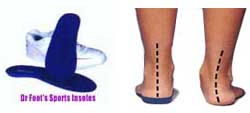
Hamstring Injury
Location
Intense pain in the back of the thigh.
Function and Anatomy of Hamstrings
The hamstrings cross two joints, the hip and the knee. They are comprised of the semi-membranosus and semi-tendinosus muscles located on the inner aspect at the back of the thigh. To the outside of the rear aspect of the thigh we find the biceps femoris. Together these three muscles make up what we commonly refer to as the hamstrings.
It is important to distinguish between a hamstring strain and sciatica as these conditions are often confused. A hamstring strain usually occurs in the centre of the thigh, unlike sciatica which will have a point of origin at the outer side of the thigh. Sciatica often produces pain in the hip, lower back and even down to the feet. All this from one nerve being pinched! A simple test to distinguish between the two is to lie on your back and raise one leg having your knee straight, if this hurts its probably a hamstring strain. Ask somebody to flex your foot, bending your foot towards your knee. If this produces pain then its probably sciatica.
How it affects your running
At first you may have trouble running at your usual pace and may shorten your running stride. As your hamstring deteriorates you will have difficulty in extending your leg as this will produce intense pain.
Causes of Hamstring Strain
This injury is usually the result of an over extension of the leg. This classic scenario is that of running or sprinting downhill at speeds that you are not accustomed to. Running on slopped roads and banked surfaces can cause a hamstring strain as the muscle is over stretched to keep a balanced running stride. Over pronation (foot imbalance) can also lead to hamstring strain.
Treatment of Hamstring Strain
Initial treatment should consist of an ice pack. Some runners prefer to use a wet towel that has been in the fridge. We recommend you use commercially available ice packs for focused pain relief. Anti-inflammatory such as Ibrobrufen will help to release the swelling. Please note this should be taken with meals and never before running.
You can continue running but it is essential that you modify your training routine. Try to run on flat surfaces, shorten your stride and decrease your speed until your injury has completely healed. The hamstring stretch is an essential aspect of your treatment regime.
Hamstring Stretch
Sit with your injured leg straight and your other leg bent. With your back straight and your head up, slowly lean forward at your waist. You should feel the stretch along the underside of your thigh. Hold the stretch for 10 to 15 seconds. Repeat the stretch 6 to 8 times. This stretching exercise may be helpful for patello-femoral syndrome (pain under and around the kneecap), patellar tendinitis (inflammation of the tendon that connects the patella and tibia) and hamstring strain (overstretching or tearing of the muscles on the back of the thigh).

Against the wall
Stand with you feet shoulder width apart and bend over and put your hands on your knees. Turn your feet slightly out to the sides and maintain weight in your big toe and outside heel. With your hands externally rotate your thighs and press out with your knees. Keep your back straight and maintain the groove in your back. From this position raise your butt up and back while rotating the pelvis forward and maintaining a flat back without losing the groove. You will feel the stretch in the hamstring group.

Recent sports studies have suggested that "retro-running" can stretch and strengthen the quadriceps and hamstrings to improve stability. Retro-running is walking or running backwards. It is important to start slowly with a slow walk and progress to a gentle jog. Choose a smooth, flat road or you can utilize a treadmill with handrails for support. Alternate your neck position to prevent strains and limit your retro-running to two sessions per week starting from 50 meters and progressing to 500 meters.
We also recommend the use of sports orthotics/ insoles to dramatically speed up recovery time. Hamstring supports provide compression and stability to the affected muscle to increase the healing phase of the injury.
Recommended Products

Best Seller- Dr Foot's Sport Insoles (pair)
Treat the underlying cause of Foot and Leg Pain
Hamstring Pain and Running Insoles

PR Freeze Spray
Instant relief
Immediate relief for Running Strains and Aches

Provides warmth, compression and support to injured thigh & hamstring areas.
Compression and Support to the Injured Hamstring

Warm up and warm down creams that relieve muscular fatigue and supply instant healing.

















